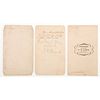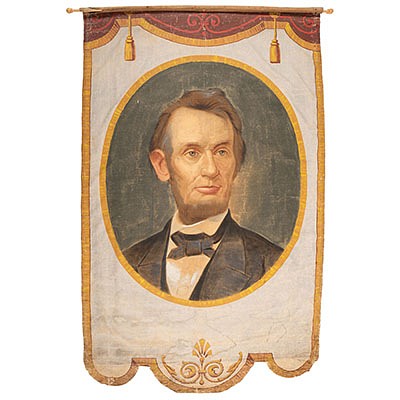[CIVIL WAR]. A group of 3 CDVs, incl. Brown Water Navy gunboats USS Lafayette and Proteus, with civilian side-wheeler SS Magenta.
About Seller
6270 Este Ave.
Cincinnati , OH 45232
United States
With offices in Cincinnati, Cleveland and Denver, Cowan’s holds over 40 auctions each year, with annual sales exceeding $16M. We reach buyers around the globe, and take pride in our reputation for integrity, customer service and great results. A full-service house, Cowan’s Auctions specializes in Am...Read more
Two ways to bid:
- Leave a max absentee bid and the platform will bid on your behalf up to your maximum bid during the live auction.
- Bid live during the auction and your bids will be submitted real-time to the auctioneer.
Bid Increments
| Price | Bid Increment |
|---|---|
| $0 | $25 |
| $500 | $50 |
| $1,000 | $100 |
| $2,000 | $250 |
| $5,000 | $500 |
| $10,000 | $1,000 |
| $20,000 | $2,500 |
| $50,000 | $5,000 |
| $100,000 | $10,000 |
About Auction
Jun 25, 2021
The June 25 American Historical Ephemera and Photography Auction features an exciting assemblage of 18th-early 20th century material, including Civil War archives, Early Photography, Western Americana, Autographs and Manuscripts, and more. Cowan's Auctions dawnie@cowans.com
- Lot Description
CDV, near profile view of the composite ironclad Lafayette photographed just off shore. Baton Rouge: A.D. Lytle, [1860s]. (Strong tones and intact corners but slightly soiled.) "Wagner's Gunboat" captioned in pencil beneath vessel without further context. Originally built as the civilian sidewheeler Aleck Scott, she was taken over by the army in 1861, renamed Fort Henry, and employed as a quartermaster stores ship. Work commenced in October 1862 to convert her to an ironclad ram designed by Commodore William D. Porter at which point she was transferred to the navy as USS Lafayette. As a gunboat, Lafayette was a flawed vessel, overweight and much too slow, nonetheless she participated in a number of significant actions during the war including Admiral Porter's epic run past fortress Vicksburg and the bombardment of Grand Gulf that presaged unrestricted Federal dominance of the Mississippi. Lafayette and her consorts operated briefly on the Red River during the closing phase of General Bank's futile expedition to isolate Texas. Stationed at New Orleans when the war ended, Lafayette was decommissioned in July 1865 and later sold out of service.
[With:]
CDV, rare view of the USS Proteus in profile. N.p.: n.p., [1860s]. (Minor foxing, clipped corners.) Inked on verso is a period inscription that reads, "Gun Boat Proteus/on board when a salute / was fired in honor of the / capture of Richmond." Beneath that in period pencil is another cryptic inscription that gives the location as "Fort Taylor Key / West F(la) / J. G. French." The name was presumed to be an officer associated with the ship, however there is no one so named in the Navy List. Proteus was a wooden screw steamer acquired by the Navy in October 1863 and commissioned in March 1864. She was assigned to the Key West Station and blockaded the southern approaches while patrolling the Windwards and Bahama Banks. Over the course of the summer Proteus ran down and captured four blockade runners including two British flagged vessels. In March 1865 she joined in a combined Army-Navy operation intended to capture Tallahassee. Unable to follow the troops up the shallow river, Proteus remained at the mouth of the St. Marks River thus denying Tallahassee's further use as a Southern port. The steamer was stricken sometime around the end of the war and sold out of service in July 1865.
[With:]
CDV of docked civilian side wheeler steamer painted with the name "Magenta" across the paddle casing. N.p.: n.p., [1860s]. (Strong detail but somewhat light due to overexposure, mount with clipped corners.) A soldier stands in the left foreground but the location of the anchorage is unknown. The vessel appears to be comparable in size, having a similar layout to the ill-fated transport Sultana.
The Richard B. Cohen Civil War Collection Lots 79-98; 116; 138-153; and 266
Cowan's is pleased to offer the third installment of Richard B. Cohen's collection of Civil War Brown Water Navy photography. Richard was known to many in the field as a "disciplined collector who maintained a relatively narrow focus having built an important, perhaps unsurpassed collection in his area of specialization." From cartes de visite to large format photographs, this portion of the collection features a noteworthy selection of images of Brown Water Navy warships, among them, the USS Benton, Choctaw, Lafayette, and Louisville. Many important identified naval officers are also represented, including an exquisite CDV of the promising young officer, Lieutenant Commander William Gwin, who died of wounds aboard the USS Benton following an artillery duel with Confederate forces at Snyder's Bluff, and an exceptionally large war-date photograph of the controversial commander of the USS Pittsburgh, Egbert Thompson.
This auction also features a premiere selection of autographs and manuscripts from Richard's carefully curated collection. Highlights include a letter from Jefferson Davis to his distant cousin, John J. Pettus, Governor of Mississippi, dated a year before secession, conveying intricate plans for securing armaments in preparation for the war; an Abraham Lincoln signed endorsement; a letter from Admiral D.G. Farragut from New Orleans, offering excellent insight into his "political" thinking as well as his dedication to his work; correspondence from Gideon Welles, David Dixon Porter, U.S. Grant, and W.T. Sherman; and a pair of superb letters with highly descriptive accounts of the Battle of the Monitor and Merrimac.
Provenance: The Richard B. Cohen Civil War CollectionCondition
- Shipping Info
-
SHIPPING & PICKUPS Cowan’s Cincinnati Office offers an in-house, full-service shipping department which is unparalleled in the auction industry. Shipping costs are provided with your finalized invoice 24-48 hours after auction. For furniture and oversized items, we recommend using third-party services. For more information, contact cowansshipping@hindmanauctions.com. NOTE: All pickups and preview are by appointment only. To make an appointment, please call 513-871-1670 or email cincinnati@hindmanauctions.com Buyers are required to pay for all packing, shipping and insurance charges. Overseas duty charges are the responsibility of the successful Bidder. Be aware that for larger and/or valuable items, shipping charges can be substantial. - Shipping charges include insurance for your order while in transit. If you have private insurance we will adjust your charge to include only packing and shipping. - Please allow 14 – 21 days after payment to package and ship your purchase as carefully as possible.
-
- Buyer's Premium



 EUR
EUR CAD
CAD AUD
AUD GBP
GBP MXN
MXN HKD
HKD CNY
CNY MYR
MYR SEK
SEK SGD
SGD CHF
CHF THB
THB![[CIVIL WAR]. A group of 3 CDVs, incl. Brown Water Navy gunboats USS Lafayette and Proteus, with civilian side-wheeler SS Magenta.](https://s1.img.bidsquare.com/item/l/8589/8589669.jpeg?t=1LMY7j)
![[CIVIL WAR]. A group of 3 CDVs, incl. Brown Water Navy gunboats USS Lafayette and Proteus, with civilian side-wheeler SS Magenta.](https://s1.img.bidsquare.com/item/s/8589/8589669.jpeg?t=1LMY7j)











